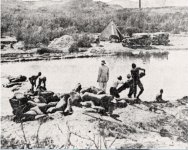You are using an out of date browser. It may not display this or other websites correctly.
You should upgrade or use an alternative browser.
You should upgrade or use an alternative browser.
Hunting Abandoned Turkish Gold 1932.
- Thread starter jeff of pa
- Start date
- Thread starter
- #3
I always wanna see treasure 

KANACKI
Bronze Member
- Mar 1, 2015
- 1,445
- 5,931
- Primary Interest:
- All Treasure Hunting
Here was some coins that was sold on consignment through a coin dealer. The coins as you can see are damaged and was worth a little more than melt value. The second factor Ottoman empire gold coins from that era was in the absolute multi millions and not rare at all.
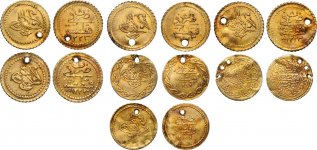
Ottoman Turks has a tendency to put holes in the coins to string them on string as dowries. Very few of the coins escaped holes punched in them.
These coins had an amazing journey.
Like this many treasure legends there is a little more to the story.
Kanacki

Ottoman Turks has a tendency to put holes in the coins to string them on string as dowries. Very few of the coins escaped holes punched in them.
These coins had an amazing journey.
Like this many treasure legends there is a little more to the story.
Kanacki
KANACKI
Bronze Member
- Mar 1, 2015
- 1,445
- 5,931
- Primary Interest:
- All Treasure Hunting
Kanacki, could you share the " More to the Story"?
Respectfully, tim
Hello timex
I shall but please be patient its very late in my part of world. I need to get the files ready. Its an amazing story. So watch this space.
Kanacki
KANACKI
Bronze Member
- Mar 1, 2015
- 1,445
- 5,931
- Primary Interest:
- All Treasure Hunting
First of all we need dig deeper into the story.
When we think of WW1 we think of great battles of Some, Ypres and Mons etc... All in Europe but in fact WW1 was a world war and fighting occurred in many countries where blood was split in the "War to end all wars" I cannot imagine the heartbreak of those heroic veterans to see another World War with in two decades of that bloodfest that it was.
In the "chess board of death" was Sinai and Palestine campaign in which the German Empire, Austria Hungarian empire and the ottoman empire took on the British empire , France, Italy and Hejaz.
The Sinai and Palestine campaign of the Middle Eastern theatre of World War One was fought by the Arab Revolt and the British Empire, against the Ottoman Empire and its Imperial German allies. It started with an Ottoman attempt at raiding the Suez Canal in 1915, and ended with the Armistice of Mudros in 1918, leading to the cession of Ottoman Syria.
Fighting began in January 1915, when a German-led Ottoman force invaded the Sinai Peninsula, then part of the British Protectorate of Egypt, to unsuccessfully raid the Suez Canal. After the Gallipoli Campaign, British Empire veterans formed the Egyptian Expeditionary Force (EEF) and Ottoman Empire veterans formed the Fourth Army, to fight for the Sinai Peninsula in 1916. During this campaign the Anzac Mounted Division and the 52nd (Lowland) Division succeeded in pushing German-led Ottoman Army units out of the area, beginning with the Battle of Romani and pursuit in August, the Battle of Magdhaba in December, and in January 1917 the newly formed Desert Column completed the recapture of the Sinai at the Battle of Rafa. These three victories, resulting in the recapture of substantial Egyptian territory, were followed in March and April, by two EEF defeats on Ottoman territory, at the First and Second Battles of Gaza in southern Palestine.
After a period of stalemate in Southern Palestine from April to October 1917, General Edmund Allenby captured Beersheba from the III Corps. Having weakened the Ottoman defences, which had stretched almost continually from Gaza to Beersheba, they were finally captured by 8 November, after the Battle of Tel el Khuweilfe, the Battle of Hareira and Sheria and the Third Battle of Gaza, when the pursuit began. During the subsequent operations, about 50 miles (80 km) of formerly Ottoman territory was captured as a result of the EEF victories at the Battle of Mughar Ridge, fought between 10 and 14 November, and the Battle of Jerusalem, fought between 17 November and 30 December.
Serious losses on the Western Front in March 1918, during Erich Ludendorff's German Spring Offensive, forced the British Empire to send reinforcements from the EEF. During this time, two unsuccessful attacks were made to capture Amman and to capture Es Salt in March and April 1918, before Allenby's force resumed the offensive during the manoeuvre warfare of the Battle of Megiddo.
The successful infantry battles at Tulkarm and Tabsor created gaps in the Ottoman front line, allowing the pursuing Desert Mounted Corps to encircle the infantry fighting in the Judean Hills and fight the Battle of Nazareth and Battle of Samakh, capturing Afulah, Beisan, Jenin and Tiberias. In the process the EEF destroyed three Ottoman armies during the Battle of Sharon, the Battle of Nablus and the Third Transjordan attack, capturing thousands of prisoners and large quantities of equipment.
Damascus and Aleppo were captured during the subsequent pursuit, before the Ottoman Empire agreed to the Armistice of Mudros on 30 October 1918, ending the Sinai and Palestine campaign. The British Mandate of Palestine and the French Mandate for Syria and Lebanon were created to administer the captured territories. The Allied forces had 61778 casualties, 16880 killed or missing, 42712 wounded, 1385 captured. The Axis forces had 189000 battle casualties, 23973 killed or missing, 85497 wounded, 78735 captured plus many more dying of disease.
It was during this some tragic forgotten campaign the following treasure story was born.
Kanacki
When we think of WW1 we think of great battles of Some, Ypres and Mons etc... All in Europe but in fact WW1 was a world war and fighting occurred in many countries where blood was split in the "War to end all wars" I cannot imagine the heartbreak of those heroic veterans to see another World War with in two decades of that bloodfest that it was.
In the "chess board of death" was Sinai and Palestine campaign in which the German Empire, Austria Hungarian empire and the ottoman empire took on the British empire , France, Italy and Hejaz.
The Sinai and Palestine campaign of the Middle Eastern theatre of World War One was fought by the Arab Revolt and the British Empire, against the Ottoman Empire and its Imperial German allies. It started with an Ottoman attempt at raiding the Suez Canal in 1915, and ended with the Armistice of Mudros in 1918, leading to the cession of Ottoman Syria.
Fighting began in January 1915, when a German-led Ottoman force invaded the Sinai Peninsula, then part of the British Protectorate of Egypt, to unsuccessfully raid the Suez Canal. After the Gallipoli Campaign, British Empire veterans formed the Egyptian Expeditionary Force (EEF) and Ottoman Empire veterans formed the Fourth Army, to fight for the Sinai Peninsula in 1916. During this campaign the Anzac Mounted Division and the 52nd (Lowland) Division succeeded in pushing German-led Ottoman Army units out of the area, beginning with the Battle of Romani and pursuit in August, the Battle of Magdhaba in December, and in January 1917 the newly formed Desert Column completed the recapture of the Sinai at the Battle of Rafa. These three victories, resulting in the recapture of substantial Egyptian territory, were followed in March and April, by two EEF defeats on Ottoman territory, at the First and Second Battles of Gaza in southern Palestine.
After a period of stalemate in Southern Palestine from April to October 1917, General Edmund Allenby captured Beersheba from the III Corps. Having weakened the Ottoman defences, which had stretched almost continually from Gaza to Beersheba, they were finally captured by 8 November, after the Battle of Tel el Khuweilfe, the Battle of Hareira and Sheria and the Third Battle of Gaza, when the pursuit began. During the subsequent operations, about 50 miles (80 km) of formerly Ottoman territory was captured as a result of the EEF victories at the Battle of Mughar Ridge, fought between 10 and 14 November, and the Battle of Jerusalem, fought between 17 November and 30 December.
Serious losses on the Western Front in March 1918, during Erich Ludendorff's German Spring Offensive, forced the British Empire to send reinforcements from the EEF. During this time, two unsuccessful attacks were made to capture Amman and to capture Es Salt in March and April 1918, before Allenby's force resumed the offensive during the manoeuvre warfare of the Battle of Megiddo.
The successful infantry battles at Tulkarm and Tabsor created gaps in the Ottoman front line, allowing the pursuing Desert Mounted Corps to encircle the infantry fighting in the Judean Hills and fight the Battle of Nazareth and Battle of Samakh, capturing Afulah, Beisan, Jenin and Tiberias. In the process the EEF destroyed three Ottoman armies during the Battle of Sharon, the Battle of Nablus and the Third Transjordan attack, capturing thousands of prisoners and large quantities of equipment.
Damascus and Aleppo were captured during the subsequent pursuit, before the Ottoman Empire agreed to the Armistice of Mudros on 30 October 1918, ending the Sinai and Palestine campaign. The British Mandate of Palestine and the French Mandate for Syria and Lebanon were created to administer the captured territories. The Allied forces had 61778 casualties, 16880 killed or missing, 42712 wounded, 1385 captured. The Axis forces had 189000 battle casualties, 23973 killed or missing, 85497 wounded, 78735 captured plus many more dying of disease.
It was during this some tragic forgotten campaign the following treasure story was born.
Kanacki
KANACKI
Bronze Member
- Mar 1, 2015
- 1,445
- 5,931
- Primary Interest:
- All Treasure Hunting
It was during the Capture of Jenin this treasure story happened.
The battle Of Jurin occurred on 20 September 1918, during the Battle of Sharon which together with the Battle of Nablus formed the set piece Battle of Megiddo fought between 19 and 25 September during the last months of the Sinai and Palestine Campaign of the First World War.
During the cavalry phase of the Battle of Sharon carried out by the Desert Mounted Corps, the 3rd Light Horse Brigade, Australian Mounted Division attacked and captured the town of Jenin located on the southern edge of the Esdraelon Plain (also known as the Jezreel Valley and the plain of Armageddon) 40–50 miles (64–80 km) behind the front line in the Judean Hills.
The Australian light horse captured about 2,000 prisoners, the main supply base and the ordnance depot of the Seventh and the Eighth Armies in and near the town. They also cut the main road from Nablus and a further 6,000 Ottoman Empire and German Empire prisoners, were subsequently captured as they attempted to retreat away from the Judean Hills.
Well just a bit of military history but what few outsiders knew only to those who was there a treasure was hidden.
Kanacki
The battle Of Jurin occurred on 20 September 1918, during the Battle of Sharon which together with the Battle of Nablus formed the set piece Battle of Megiddo fought between 19 and 25 September during the last months of the Sinai and Palestine Campaign of the First World War.
During the cavalry phase of the Battle of Sharon carried out by the Desert Mounted Corps, the 3rd Light Horse Brigade, Australian Mounted Division attacked and captured the town of Jenin located on the southern edge of the Esdraelon Plain (also known as the Jezreel Valley and the plain of Armageddon) 40–50 miles (64–80 km) behind the front line in the Judean Hills.
The Australian light horse captured about 2,000 prisoners, the main supply base and the ordnance depot of the Seventh and the Eighth Armies in and near the town. They also cut the main road from Nablus and a further 6,000 Ottoman Empire and German Empire prisoners, were subsequently captured as they attempted to retreat away from the Judean Hills.
Well just a bit of military history but what few outsiders knew only to those who was there a treasure was hidden.
Kanacki
Last edited:
KANACKI
Bronze Member
- Mar 1, 2015
- 1,445
- 5,931
- Primary Interest:
- All Treasure Hunting
In 1924 the following newspaper story was published in Daily Mercury (Mackay, Qld. : 1906 - 1954) Australia
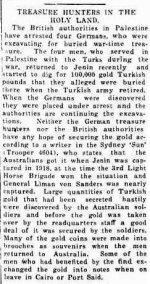
TREASURE HUNTERS IN THE HOLY LAND.
The British , authorities in Palestine have arrested four Germans, who were excavating for buried war-time treasure... The. four men, who served in Palestine with" the Turks during the war, returned to Jenin recently and
started to dig. for 100,000 gold Turkish pounds that they alleged were buried there when the Turkish army retired.
When the Germans" were discovered they_were placed under arrest and the authorities are continuing the excavations.
Neither the German treasure hunters nor the British' authorities have any hope of securing the gold according to a. writer in the Sydney 'Sun'
(Trooper 4604), who states that the Australians got it when Jenin was captured in 1918, at the time the 3rd Light
Horse Brigade won the situation and General Liman von Sanders was nearly captured. Large quantities of Turkish
gold that had been secreted hastily were discovered by the Australian soldiers and before the gold was, taken
over by the Headquarters staff a good deal of it was secured by the soldiers.
Many of the gold coins were made into brooches as souvenirs when; the.men returned to Australia some of the
men had benefited by the find exchanged the. gold into notes when, on leave in Cairo or Port Said.
The following picture below shows how some looted coins was made into war jewelry.
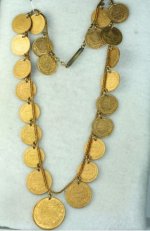
That was not all the story but the beginning....
Kanacki

TREASURE HUNTERS IN THE HOLY LAND.
The British , authorities in Palestine have arrested four Germans, who were excavating for buried war-time treasure... The. four men, who served in Palestine with" the Turks during the war, returned to Jenin recently and
started to dig. for 100,000 gold Turkish pounds that they alleged were buried there when the Turkish army retired.
When the Germans" were discovered they_were placed under arrest and the authorities are continuing the excavations.
Neither the German treasure hunters nor the British' authorities have any hope of securing the gold according to a. writer in the Sydney 'Sun'
(Trooper 4604), who states that the Australians got it when Jenin was captured in 1918, at the time the 3rd Light
Horse Brigade won the situation and General Liman von Sanders was nearly captured. Large quantities of Turkish
gold that had been secreted hastily were discovered by the Australian soldiers and before the gold was, taken
over by the Headquarters staff a good deal of it was secured by the soldiers.
Many of the gold coins were made into brooches as souvenirs when; the.men returned to Australia some of the
men had benefited by the find exchanged the. gold into notes when, on leave in Cairo or Port Said.
The following picture below shows how some looted coins was made into war jewelry.

That was not all the story but the beginning....
Kanacki
KANACKI
Bronze Member
- Mar 1, 2015
- 1,445
- 5,931
- Primary Interest:
- All Treasure Hunting
Well decades after WW1 families of returned servicemen allover Australia who had served in the Australian light horse had thousands of these coins. By the 1930's when the great depression hit many of these coins was later sold to pawn brokers or collectors.
The following coins was hidden inside the back of a dusty glass picture frame inside a attic of a house of WW2 vet whose father served in the Australian light horse in WW1.
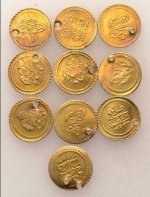
But it not all the story because as some of Germans retreated across the river Jordan which was in flood at the time. Burdened with weight in gold German and Ottoman troops tossed the remain coins that was not buried at Jenin into the river Jordan to avoid seizure by the British.
Hence attempts in the 1930s in recovering the coins from the mud of river Jordan in 1932. Jeffs wonderful newspaper story and picture of the recovery attempt.
Kanacki
The following coins was hidden inside the back of a dusty glass picture frame inside a attic of a house of WW2 vet whose father served in the Australian light horse in WW1.

But it not all the story because as some of Germans retreated across the river Jordan which was in flood at the time. Burdened with weight in gold German and Ottoman troops tossed the remain coins that was not buried at Jenin into the river Jordan to avoid seizure by the British.
Hence attempts in the 1930s in recovering the coins from the mud of river Jordan in 1932. Jeffs wonderful newspaper story and picture of the recovery attempt.
Kanacki
Last edited:
KANACKI
Bronze Member
- Mar 1, 2015
- 1,445
- 5,931
- Primary Interest:
- All Treasure Hunting
In Jeff's 1932 newspaper article the name of Belsan has been miss spelled. Its real name is Bisan is a Canaanite city that means the “home of gods”. Its history can be traced to more than 6000 years. It is located on a high land in the western side of the valley, 5 miles east the Jordan River, between Tabariah, Al-Nassera, Nabless, and Janeen.
Today the site of the alleged dumping treasure sits on the border between Jordan and Israel. The river Jordan acts as border.. On the hills above in Jordan and Israel have military posts overlooking the site.
Technically there could be another 15000 coins dumped in river somewhere. The logical places to search was the crossing points that existed in 1918.
Kanacki
Today the site of the alleged dumping treasure sits on the border between Jordan and Israel. The river Jordan acts as border.. On the hills above in Jordan and Israel have military posts overlooking the site.
Technically there could be another 15000 coins dumped in river somewhere. The logical places to search was the crossing points that existed in 1918.
Kanacki
KANACKI
Bronze Member
- Mar 1, 2015
- 1,445
- 5,931
- Primary Interest:
- All Treasure Hunting
Janeen is Palestinian spelling of Jenin the very place where 100000 coins recovered by Australian troops on the airstrip in 1918. Today there is no cross point over the river Jordan due various later conflicts. The rail bridge lies abandoned as you can see below.
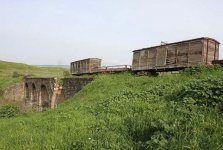
The disorganized retreating Ottoman army retreated over the railway bridge the railway link had been already cut because of Arab army pincer movement. Thus with no train, no vehicles the solider retreating for their lives was ordered to dump the remaining coins into the river Jordan.
Kanacki

The disorganized retreating Ottoman army retreated over the railway bridge the railway link had been already cut because of Arab army pincer movement. Thus with no train, no vehicles the solider retreating for their lives was ordered to dump the remaining coins into the river Jordan.
Kanacki
Last edited:
KANACKI
Bronze Member
- Mar 1, 2015
- 1,445
- 5,931
- Primary Interest:
- All Treasure Hunting
It was from these turbulent times the German officers who was part of General Liman von Sanders attache to the Ottoman army made notes and maps of the location of the discarded. History tells us the Ottoman empire collapsed and there was no longer any effort to recover the coins by that country. Except 4 retired German officer saw their chance to recover the gold in 1924.
Here is a picture of General Liman von Sanders below.
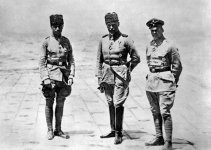
Kanacki
Here is a picture of General Liman von Sanders below.

Kanacki
Last edited:
KANACKI
Bronze Member
- Mar 1, 2015
- 1,445
- 5,931
- Primary Interest:
- All Treasure Hunting
In Bisan the story became a local treasure legend. Many treasure hunters tried their luck. However the area is dangerous as it straddles no mans land. Yet both in Jordan and Israel treasure hunting and metal detecting is illegal. Yet it has not deterred hopefuls of finding treasure in the mud of the river. Yet now it appears actions made by random rumors such as the treasure was hidden inside the bridge itself? Has resulted in destruction of bridge ruins.
https://www.haaretz.com/1.4686776
Kanacki
https://www.haaretz.com/1.4686776
Kanacki
BillA
Bronze Member
Hi Kanacki,
And the linked to article is a whitewash, to be expected I suppose.
Would be interesting to see a map of the course that the retreating army took, similar to Napoleon in Russia (or even less organized) ?
And the linked to article is a whitewash, to be expected I suppose.
Would be interesting to see a map of the course that the retreating army took, similar to Napoleon in Russia (or even less organized) ?
KANACKI
Bronze Member
- Mar 1, 2015
- 1,445
- 5,931
- Primary Interest:
- All Treasure Hunting
Hello Bill
Indeed I have military map of area and battle during 1918. if your eyes are good you can see why the Germans and ottomans retreated from Jenin and crossed the river Jordan. They had to cross by a road bridge or railway bridge because the river Jordan at the time was in flood. The maps shows all the crossing points across the river Jordan.
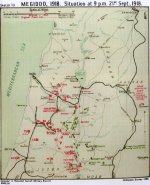
In the late 1920's and 1930's as knowledge evolved opportunists started selling fake maps.
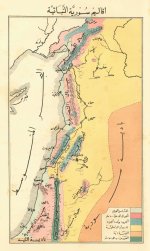
Kanacki
Indeed I have military map of area and battle during 1918. if your eyes are good you can see why the Germans and ottomans retreated from Jenin and crossed the river Jordan. They had to cross by a road bridge or railway bridge because the river Jordan at the time was in flood. The maps shows all the crossing points across the river Jordan.

In the late 1920's and 1930's as knowledge evolved opportunists started selling fake maps.

Kanacki
Last edited:
BillA
Bronze Member
Hi Kanacki,
jeez, I feel like Aladdin; say Hi, make a wish . . . . and BOOM, it appears
lol
In a previous life I had occasion to fly around the mid-east, and when crossing Syria and Jordan I always had a window seat.
It was fascinating to observe that every rise or promontory showed obvious signs of habitation, fortifications from various epochs, abandoned roads, the works. 7000 years of human occupation do take their toll.
Man-o-man did I want to dig.
And the retreating forces of that army would be good to retrace - but not today.
And where were the Armenians driven out of their houses to perish in the desert would be interesting - if ghoulish.
jeez, I feel like Aladdin; say Hi, make a wish . . . . and BOOM, it appears
lol
In a previous life I had occasion to fly around the mid-east, and when crossing Syria and Jordan I always had a window seat.
It was fascinating to observe that every rise or promontory showed obvious signs of habitation, fortifications from various epochs, abandoned roads, the works. 7000 years of human occupation do take their toll.
Man-o-man did I want to dig.
And the retreating forces of that army would be good to retrace - but not today.
And where were the Armenians driven out of their houses to perish in the desert would be interesting - if ghoulish.
BillA
Bronze Member
Hola Kanacki,
Indeed, and I live on the edge of the jungle w/o a road.
Similar idea.
Indeed, and I live on the edge of the jungle w/o a road.
Similar idea.
Top Member Reactions
-
 2350
2350 -
 1127
1127 -
 1048
1048 -
 886
886 -
 826
826 -
 801
801 -
 753
753 -
 752
752 -
 606
606 -
 499
499 -
 491
491 -
 473
473 -
 466
466 -
 423
423 -
 385
385 -
 382
382 -
 381
381 -
 381
381 -
 376
376 -
O
375
Users who are viewing this thread
Total: 2 (members: 0, guests: 2)

